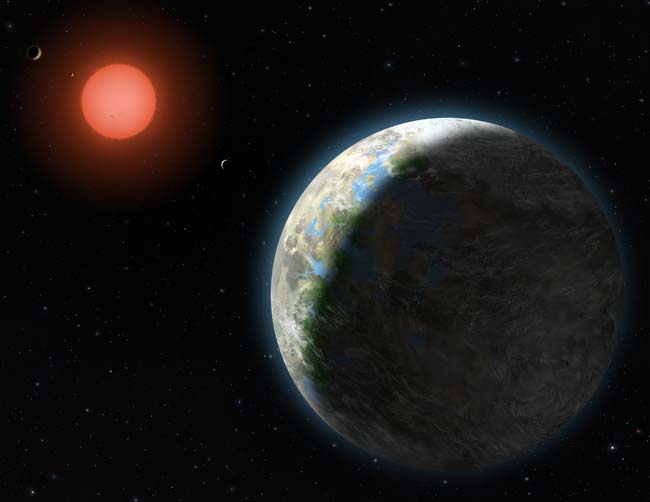
The announcement Wednesday (Sept. 29) of two newfound alien planets circling the star Gliese 581 adds to the nearby solar system's intrigue, further cementing its status as a top candidate to harbor extraterrestrial life.
One of the two newly discovered planets, known as Gliese 581g, is a small, Earth-like world that likely lies within its star's habitable zone — the just-right range of distances that allow liquid water to exist. [Artist's conception of Gliese 581g.]
Astronomers have now detected six planets orbiting Gliese 581, the most known to circle any star beyond our own sun. Here's a brief tour of the star and its planets, from the inside out:
Gliese 581: the mother star
Gliese 581 is a red dwarf located 20.5 light-years from Earth, in the constellation Libra. Like other red dwarfs, it's smaller and much dimmer than our sun. Scientists believe Gliese 581 is old — at least a few billion years — and relatively stable. Both are qualities conducive to the evolution of life, scientists have said.
Nearest planet
The nearest planet to the star is Gliese 581e, a rocky world nearly twice as massive as Earth.
Gliese 581e is extremely close to its parent star — it completes an orbit every 3.15 days — so it's likely far too hot for life to have any chance of taking root.
Gliese 581e is about 0.033 astronomical units from its parent star. One astronomical unit, or AU, is the average distance between the Earth and sun, about 93 million miles (150 million km).
Get the Space.com Newsletter
Breaking space news, the latest updates on rocket launches, skywatching events and more!
Astronomers announced this planet's discovery in April 2009, and it's in the running for the lightest known extrasolar planet. So far, the only potential alien planet less massive than Gliese 581e is a world about 1.4 times the mass of Earth, but its existence — around a more distant star — has not yet been confirmed.
Next up: Gliese 581b
Traveling outward, the next planet is Gliese 581b, a Neptune-size alien world that's about 16 times as massive as Earth. This planet is still very close to the star, completing an orbit in 5.4 days.
Astronomers first discovered this planet in December 2005, according to an extrasolar planet database maintained by NASA's Jet Propulsion Laboratory. Its average distance from the Gliese 581 star is about 0.041 AU.
Rocky world in third
Gliese 581c comes next. This is a rocky, smallish planet — about five Earth masses — that makes a full trip around the red dwarf every 15 days.
Astronomers once thought Gliese 581c might be in the habitable zone, but later observations suggested the planet is likely too hot to support liquid water or life. The planet is about 0.073 AU from its parent star.
Meet Gliese 581g
Unlike Gliese 581c, the newfound planet Gliese 581g looks much more hospitable. It is orbiting within the habitable zone of its parent star.
Gliese 581g is three to four times as massive as Earth, is most likely rocky, and may have an atmosphere, scientists say. It orbits about 0.146 AU from the central star.
Liquid water could exist on some part of the planet's surface, which seems to have an average temperature between minus 24 and minus 10 degrees Fahrenheit (minus 31 to minus 12 degrees Celsius). Gliese 581g completes an orbit every 37 days or so.
Fifth planet is a super-Earth
The next planet in line is a so-called super-Earth, Gliese 581d, which is seven or eight times as massive as Earth and completes an orbit every 67 days.
Though at first glance this planet appeared to be beyond the star's habitable zone, astronomers think it might just squeak in — computer models suggest a greenhouse effect could be warming its surface. It was discovered in April 2007 and orbits about 0.22 AU from its parent star.
Sixth planet on the outskirts
The outermost planet in the Gliese 581 system (that astronomers know about, anyway) is the newly discovered Gliese 581f, announced today.
This planet is much farther away than the other five planets, zipping through space far outside the habitable zone, but it is still closer to its parent star than the Earth is to our sun. The planet is about 0.76 AU from its parent star.
Like all of the planets in the Gliese 581 system — and in our own solar system — Gliese 581f's orbit is nearly circular, scientists said.
Join our Space Forums to keep talking space on the latest missions, night sky and more! And if you have a news tip, correction or comment, let us know at: community@space.com.

Michael Wall is a Senior Space Writer with Space.com and joined the team in 2010. He primarily covers exoplanets, spaceflight and military space, but has been known to dabble in the space art beat. His book about the search for alien life, "Out There," was published on Nov. 13, 2018. Before becoming a science writer, Michael worked as a herpetologist and wildlife biologist. He has a Ph.D. in evolutionary biology from the University of Sydney, Australia, a bachelor's degree from the University of Arizona, and a graduate certificate in science writing from the University of California, Santa Cruz. To find out what his latest project is, you can follow Michael on Twitter.









